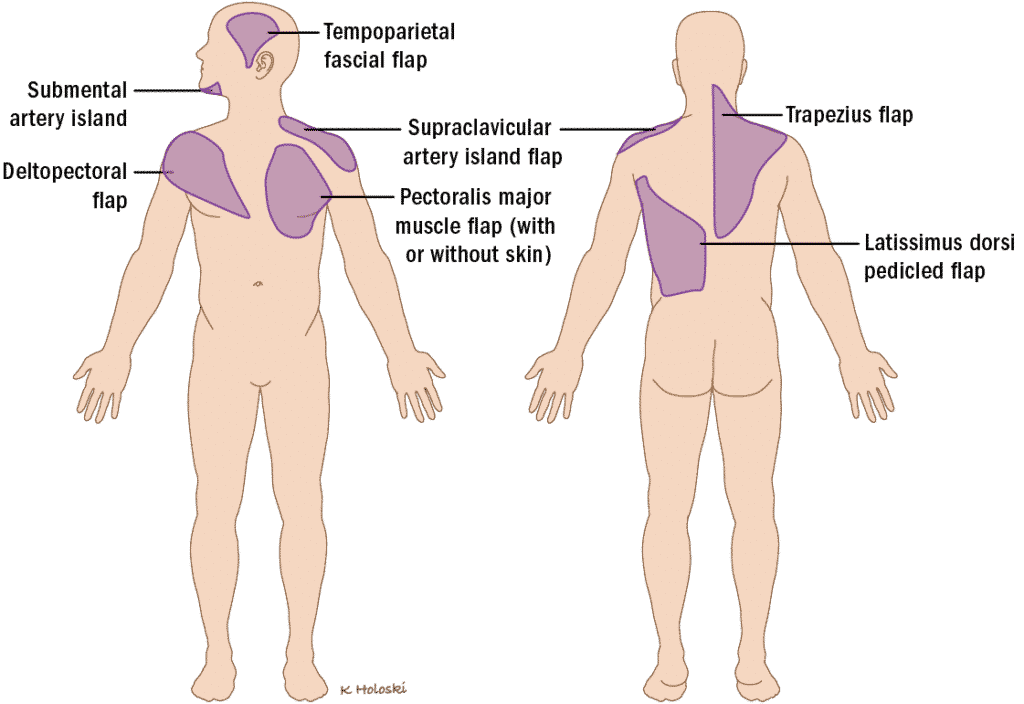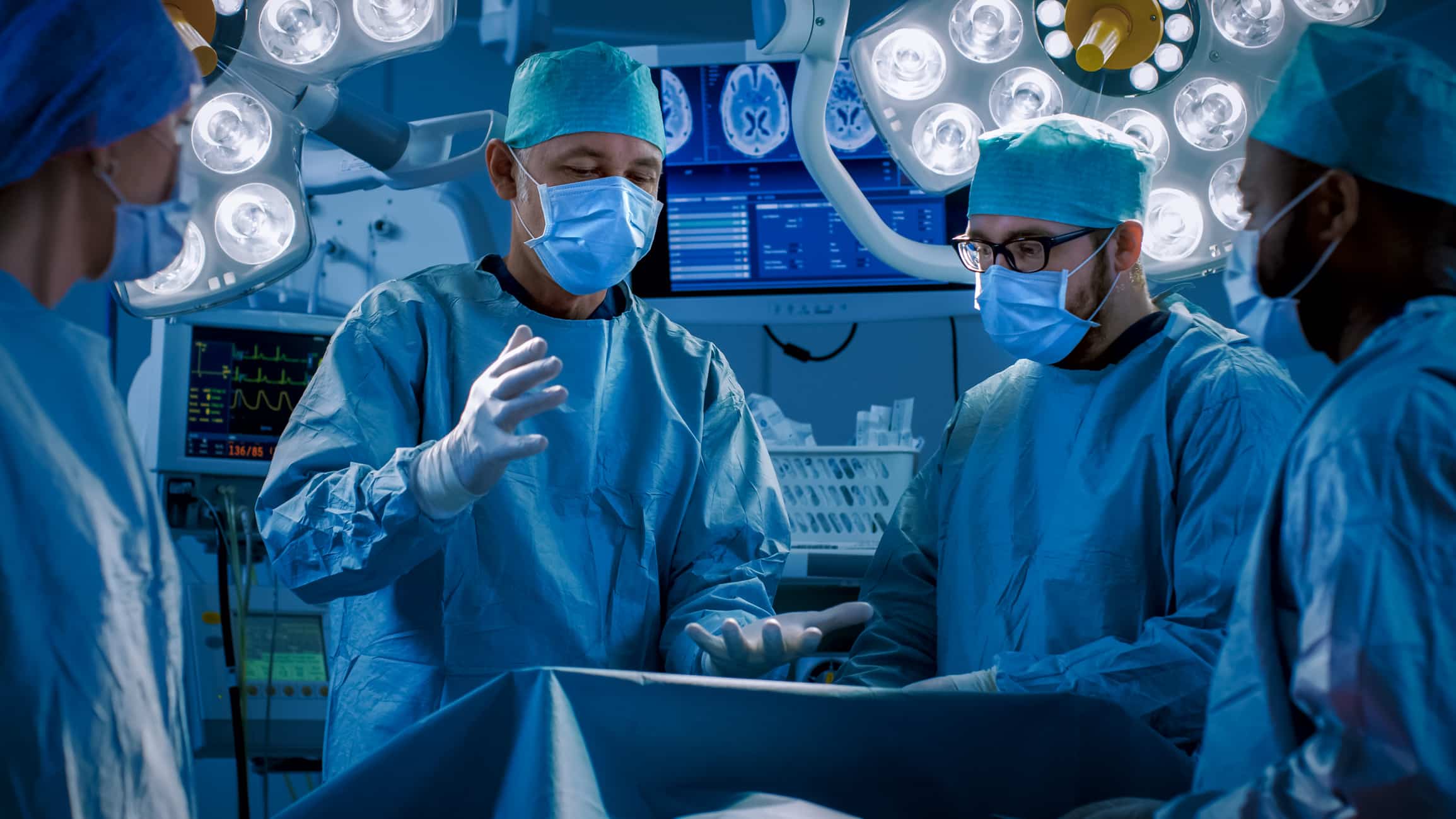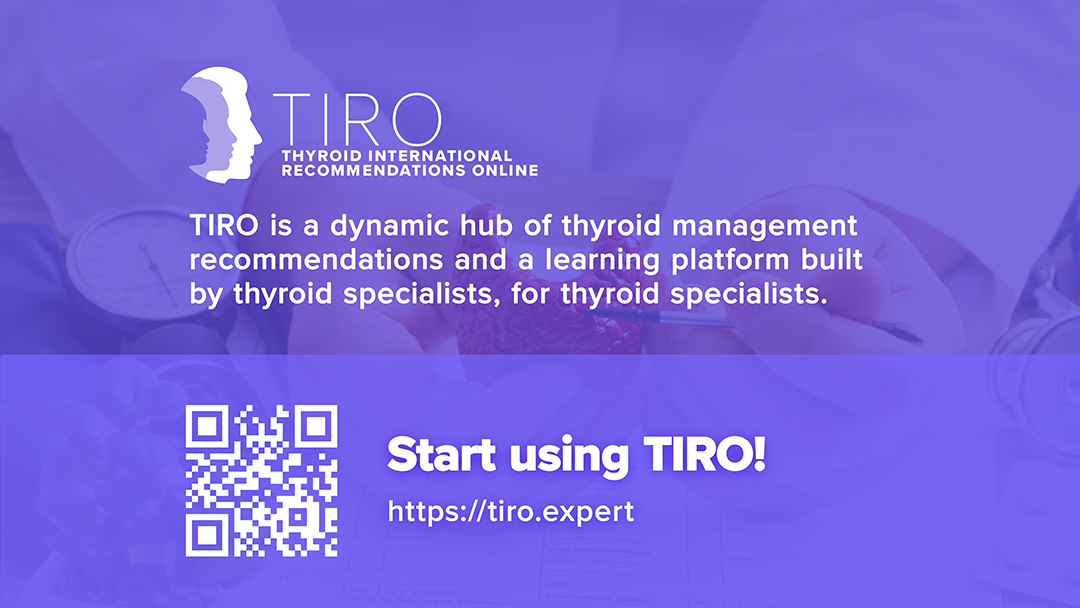Tissue removal as part of cancer treatment, known as ablative surgery, necessitates reconstruction of the tissue that was removed. Reconstructive surgery may be performed either by the same surgeon who performed the ablative surgery or by a surgeon who specializes in head and neck reconstruction.
When considering the best reconstructive option, issues of safety (protecting vital structures), overcoming impaired wound healing related to prior radiation and/or chemotherapy, restoring or improving appearance, and function (optimizing breathing, chewing, speaking, and swallowing) are taken into account. The simplest reconstruction that achieves all of these goals is usually the best option. To that end, if a patient is undergoing ablative surgery for treatment of a head and neck cancer, it is important to understand some basic reconstructive methods.
Healing by Secondary Intention
Healing by secondary intention occurs when the wound created by removing the cancer is not fully closed, and is allowed to heal and scar on its own. A wound that heals by secondary intention requires close care and daily follow-up. Any packing or wound closure devices must be changed regularly to remove any dead tissue and promote healthy healing.
Often, patients are able to care for the wound on their own, but sometimes they may require the help of a family member or a home help nurse. Although the simplest type of reconstruction, this form of healing may be painful until fully healed and there is inevitable scarring that leads to contraction of the wound. Depending on the location, this may lead to distortion of surrounding structures that may be an unwanted consequence.
Cases for Healing by Secondary Intention
- Robotic or laser-assisted transoral resection of tumors in the oropharynx, tonsil, base of tongue, or larynx.
- Resection of minor salivary gland cancers of the hard palate (roof of the mouth) that does not require removal of bone.
- Removal of skin cancer in select areas of the face.
Primary Closure
Primary closure occurs when a wound is closed by bringing the edges together with stitches, staples, tape, or skin glue. The end result is a thin scar located where the surgical incision was made.
Aftercare of a wound that is sealed by primary closure is quite simple. A surgeon might ask their patient to avoid getting it wet for one to three days to prevent infection. It is also recommended that it be kept out of the sun or covered with sunscreen when they go outside to prevent discoloration of the scar. This site should be monitored for up to six months following surgery in order to optimize the end result. In addition, over-the-counter scar creams can be used to help improve the appearance.
Cases for Primary Closure
- Incisions made to remove tumors deep in the neck or face that don’t require removal of the overlying skin.
- Excision of small areas of skin along with removal of deeper tissue in the face or neck.
- Removal of some small cancers of the oral cavity, such as on the tongue, inner aspect of the cheek, or floor of mouth.
Skin Grafts
A skin graft is a method of covering a wound with a very thin layer of skin that is removed from another part of the head, neck, or other parts of the body. The skin graft does not have its own blood supply. Instead, it relies on the growth of blood vessels into the graft from the wound, a process known as imbibition.
This occurs over the course of approximately one week, during which time a dressing is usually sutured in place over the skin graft to keep it tight against the wound. Movement of the skin graft relative to the underlying wound bed can be detrimental to the growth of blood vessels into the skin graft.
Disadvantages Associated with Skin Grafts
- Skin grafts can contract and lead to scar bands.
- When a skin graft contracts inside the mouth, it can sometimes cause difficulty with speaking and tongue mobility.
Types of Skin Grafts
Split Thickness Skin Graft
A split thickness skin graft is a skin graft that is not the full thickness of the skin. These are often taken from the thigh. The wound from which the graft is taken is left to heal on its own.
Advantages: A split thickness skin graft is more likely to be successful than a full thickness graft because it is thinner and thus easier for blood vessels from the surrounding tissue to feed it. The donor site (area from which the skin was taken) is left to heal without any sutures. Large grafts can be taken with minimal scarring or healing complications at the donor site.
Full Thickness Skin Graft
A full thickness skin graft is a thicker skin graft that includes all layers of the skin. It involves cutting a piece of skin from another part of the body and requires primary closure.
Advantages: There is less contracture (or shrinkage) of the graft. If taken from a well-planned area, the final color match (and thus appearance) of the skin can be better than a split thickness skin graft.
Skin Substitute
Instead of taking a skin graft, some surgeons will use artificial, or synthetic, skin substitutes. While nothing works better than the patient’s own skin, a skin substitute eliminates the donor site morbidity associated with taking a graft from another part of the body.
Advantages: Covers exposed muscle or fascia after another form of reconstruction. Lines the remaining maxillary sinus after a maxillectomy to help with retention of a prosthesis. Can be used to reconstruct thin eyelid skin or improve appearance after facial skin excisions.
Local Flaps
A local flap involves rotating or moving skin from an area nearby to a surgical defect to close the surgical wound. A local flap is not based on a defined artery and vein. Local flaps are typically used after skin cancer removal or removal of small surface-level tumors on the face or neck.
Advantages
The advantages of a local flap are that they are technically easier (but still require expertise and careful planning to get the best outcome), require shorter operative times, and generally match the skin color and thickness better than skin grafts, regional flaps, and free flaps.
Disadvantages
A disadvantage of using a local flap is that the size of the flap is limited to relatively small defects.
Regional Flaps
A regional flap uses tissue from a part of the body near the head and neck region while keeping it attached to its regional blood supply. The flap of skin and/or muscle is rotated into the surgical defect, with the blood supply still connected to the donor site via a vascular pedicle. Compared to free flap surgery, regional flap surgery is quicker and requires less post-operative care and monitoring. However, because a regional flap must remain attached to its blood supply, there is less flexibility in flap size, thickness, and ability to reach certain locations.
Pectoralis Major Muscle Flap
A regional flap commonly used in head and neck surgery is the pectoralis major muscle or musculocutaneous flap. The pectoralis major muscles are located on the front of the upper chest and extend from the humerus and clavicle (collarbone) to the mid-ribs. Depending on the type of reconstruction required, the pectoralis flap may or may not involve taking a small amount of skin from the chest in addition to the muscle.
Latissimus Dorsi Flap
Another regional flap regularly used for head and neck reconstructive surgery is taken from the latissimus dorsi, a large flat muscle that extends from the middle to lower back. It is located on the side of the chest on the flank region of both sides of the body. The latissimus dorsi muscle has the greatest surface area of any muscle in the body and can be used to cover larger surgical defects. It can be harvested as muscle alone or with a segment of the overlying skin of this region.
The following figure demonstrates a variety of commonly used regional flaps that each offer a unique set of advantages and are accompanied by certain disadvantages.

Free Flaps
Free flap surgery, also referred to as free tissue transfer or microvascular reconstruction, involves removing a segment of tissue and its blood supply from one part of the body and transplanting it to another part of the body. The types of tissue that can be transferred include skin, muscle, fascia, bone, bowel, and combinations of tissue that may be required for the specific defect that is being restored. The artery and vein of the flap are sewn to an artery and vein near the wound to provide the flap with a new blood supply. This procedure is performed under a microscope using very fine sutures.
Advantages of Free Flap Reconstruction
- The flap is new, healthy tissue that is distant from any previous surgery or radiation.
- Bone, muscle, skin, fascia, fat and nerves can all be transferred to the donor site to match the tissue that was removed as precisely as possible.
- The flap can cover wounds of various sizes and thicknesses.
- Unlike a skin graft, the skin of a free flap does not contract.
Free flaps do, however, require special technical expertise, extra surgical time, and close monitoring to identify and correct any blood supply problems that may occur during the postoperative period. If a clot forms in the artery or vein that serves the flap, the flap can fail. If this happens, the patient will require either an additional free flap or another type of reconstruction that may not be as desirable.
Tissue for a free flap can be taken from almost anywhere in the body, as long as it is well vascularized. Some of the more common types of free flaps and examples of their use in head and neck reconstruction are summarized in the following table:
Type Description Uses Rectus Abdominis Harvested from the front of the abdominal wall.
Provides either thick skin with healthy muscle or healthy muscle alone.Total tongue
Skull base
ScalpRadial Forearm Harvested from the solar surface of the forearm along with one of the 2 arteries that supplies the hand.
Provides thin, pliable skin and fascia that can line large defects or be turned into a tube.Oral cavity
Partial tongue
Skull base
Partial or total pharynx (throat)
Hard and soft palate
LipRadial Forearm with Bone Harvested from part of the circumference of the radius, and has limited strength.
Provides thin, pliable skin combined with a thin piece of bone, known as the radius.Maxilla (upper jaw)
Orbital floor (base of eye)Anterolateral Thigh Harvested from the front of the thigh.
Provides thicker skin, fascia, and sometimes muscle for slightly larger defects.Total or subtotal tongue
Partial or total pharynx (throat)
Skull base
MidfaceFibula Harvested from the central portion of the bone on the side of the calf, while preserving the portion of that bone that makes up the ankle and the knee joints.
Harvest is only possible when it is determined that the circulation to the foot is well preserved by the other 2 arteries that run through the calf.
Provides reliable long bone, with or without skin.Mandible (lower jaw)
Maxilla (upper jaw)
Most bone defects of the head and neckScapular System Harvested from the shoulder blade on the upper back.
Provides multiple mobile components including bone, skin, and muscle.Large defects that require a large amount and variety of tissue types.
Bone defects where a fibula cannot be safely used because of vascular disease in the legs.
Top Questions for Your Doctor
Access our list of the most important questions to ask your physician at your next appointment.












